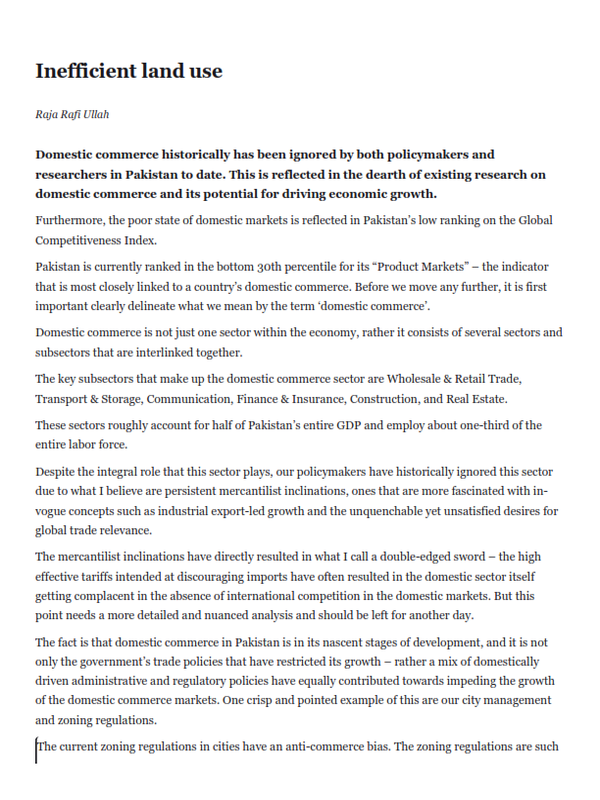
Pakistan Institute of Development Economics
- Home
Our Portals
MenuMenuMenuMenuMenuMenuMenu - ResearchMenuMenuMenuMenuMenuMenuMenu
- Discourse
- The PDR
- Our Researchers
- Academics
- Degree Verification
- Thesis Portal
- Our Portals
Inefficient land use
Domestic commerce historically has been ignored by both policymakers and researchers in Pakistan to date. This is reflected in the dearth of existing research on domestic commerce and its potential for driving economic growth.
Furthermore, the poor state of domestic markets is reflected in Pakistan’s low ranking on the Global Competitiveness Index.
Pakistan is currently ranked in the bottom 30th percentile for its “Product Markets” – the indicator that is most closely linked to a country’s domestic commerce. Before we move any further, it is first important clearly delineate what we mean by the term ‘domestic commerce’.
Domestic commerce is not just one sector within the economy, rather it consists of several sectors and subsectors that are interlinked together.
The key subsectors that make up the domestic commerce sector are Wholesale & Retail Trade, Transport & Storage, Communication, Finance & Insurance, Construction, and Real Estate.
These sectors roughly account for half of Pakistan’s entire GDP and employ about one-third of the entire labor force.
Despite the integral role that this sector plays, our policymakers have historically ignored this sector due to what I believe are persistent mercantilist inclinations, ones that are more fascinated with in-vogue concepts such as industrial export-led growth and the unquenchable yet unsatisfied desires for global trade relevance.
The mercantilist inclinations have directly resulted in what I call a double-edged sword – the high effective tariffs intended at discouraging imports have often resulted in the domestic sector itself getting complacent in the absence of international competition in the domestic markets. But this point needs a more detailed and nuanced analysis and should be left for another day.
The fact is that domestic commerce in Pakistan is in its nascent stages of development, and it is not only the government’s trade policies that have restricted its growth – rather a mix of domestically driven administrative and regulatory policies have equally contributed towards impeding the growth of the domestic commerce markets. One crisp and pointed example of this are our city management and zoning regulations.
The current zoning regulations in cities have an anti-commerce bias. The zoning regulations are such that they favor single-use low-rise family houses while restricting domestic commerce activities to rigidly defined ‘commercial zones’. These policies have led to a scarcity of commercial space in cities with businesses being charged exorbitant rates for office and commercial space.
This in turn has resulted in many businesses illegally using residential zones for commercial activities. The outdated zoning regulations combined with building height restrictions mean that there is only limited room for both high-rise and mixed-use utilization of urban land.
The land use regulations in the cities also remain very complex and open to interpretation. There is an immediate need to revise these building regulations in most cities so they are more conducive to the growth of domestic commerce.
For instance, in Lahore, which is the second-biggest urban center in the country, the Land Use Regulations do not have any provision for mixed-use land in ‘residential zones’ – there is only a provision that allows for small corner shops to be built at the discretion of authorities.
The opportunity cost that is incurred from this inefficient use of land in terms of effectively suffocating commercial and economic activity is significant.
To sum up, the current zoning laws favour low-rise residential single-unit housing. This leads to urban sprawling and leaves less room for commercial activities. Mixed-use of land ,i.e., allowing a plot of land to be used for both commercial and residential activities needs to be adopted in all city ‘zones’ whatsoever.
This, however, would require a fundamental rethink of the current zoning laws that divide city space into inflexible categories such as ‘residential’ and ‘commercial’. But if it were to be implemented and corrected, this can alleviate some of the shortage of commercial and office space in cities and contribute to our economic growth.
Copyright Business Recorder, 2023



